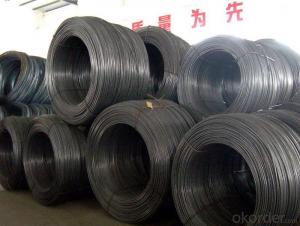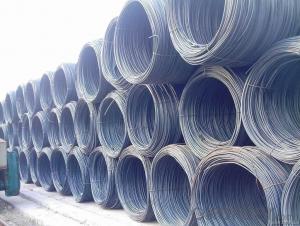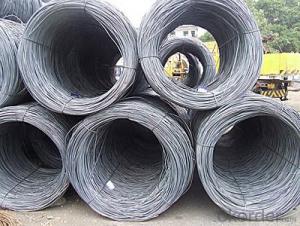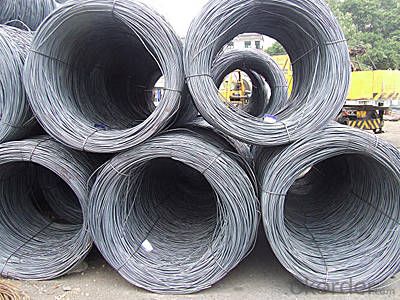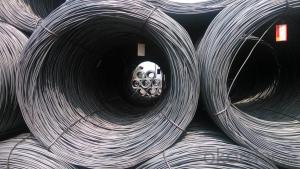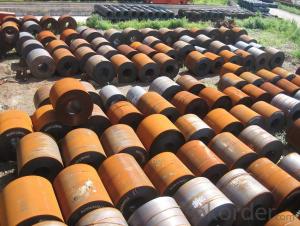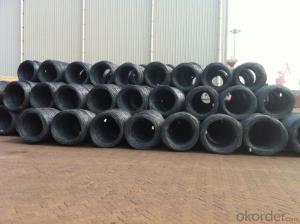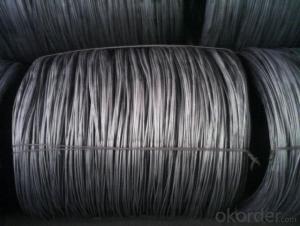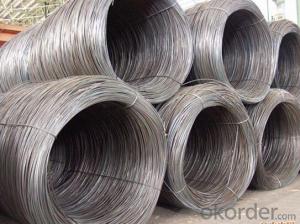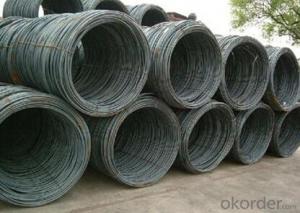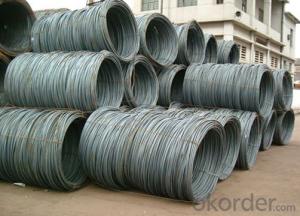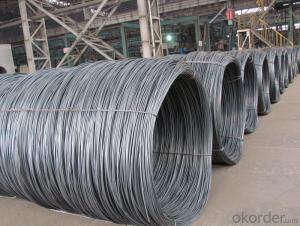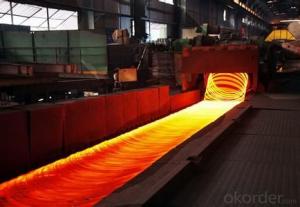Wire Rod High Qulity Hot Rolled Sae 1008b 5.5mmin Coils
- Loading Port:
- Tianjin
- Payment Terms:
- TT or LC
- Min Order Qty:
- 25 m.t.
- Supply Capability:
- 20000 m.t./month
OKorder Service Pledge
OKorder Financial Service
You Might Also Like
Product Description:
OKorder is offering Wire Rod High Qulity Hot Rolled Sae 1008b 5.5mmin Coils at great prices with worldwide shipping. Our supplier is a world-class manufacturer of steel, with our products utilized the world over. OKorder annually supplies products to European, North American and Asian markets. We provide quotations within 24 hours of receiving an inquiry and guarantee competitive prices.
Product Applications:
Wire Rod High Qulity Hot Rolled Sae 1008b 5.5mmin Coils are ideal for structural applications and are widely used in the construction of buildings and bridges, and the manufacturing, petrochemical, and transportation industries.
Product Advantages:
OKorder's Wire Rod High Qulity Hot Rolled Sae 1008b 5.5mmin Coils are durable, strong, and resist corrosion.
Main Product Features:
· Premium quality
· Prompt delivery & seaworthy packing (30 days after receiving deposit)
· Corrosion resistance
· Can be recycled and reused
· Mill test certification
· Professional Service
· Competitive pricing
Product Specifications:
hot rolled sae 1008b wire rod
1 .high quality
2. prompt delivery date
3. competive price and full size
| Product | wire rod |
| Standard | AISI,ASTM,BS,DIN,JIS,GB |
| Grade | Q195,Q235,SAE1006,SAE1008,SAE1018B,H08A,30MnSi,62B-82B |
| Diameter | 5.5mm-14mm |
| Coils weight | around 2 tons |
| MOQ | 100 Metric Ton,also depending on production schedule |
| Delivery Time | 25-45 Days |
| Packing | Standard export packing or as you required |
| Payment term | T/T, L/C |
| Application | construction |
FAQ:
Q1: Why buy Materials & Equipment from OKorder.com?
A1: All products offered byOKorder.com are carefully selected from China's most reliable manufacturing enterprises. Through its ISO certifications, OKorder.com adheres to the highest standards and a commitment to supply chain safety and customer satisfaction.
Q2: How do we guarantee the quality of our products?
A2: We have established an advanced quality management system which conducts strict quality tests at every step, from raw materials to the final product. At the same time, we provide extensive follow-up service assurances as required.
Q3: How soon can we receive the product after purchase?
A3: Within three days of placing an order, we will begin production. The specific shipping date is dependent upon international and government factors, but is typically 7 to 10 workdays.
Q4: What makes stainless steel stainless?
A4: Stainless steel must contain at least 10.5 % chromium. It is this element that reacts with the oxygen in the air to form a complex chrome-oxide surface layer that is invisible but strong enough to prevent further oxygen from "staining" (rusting) the surface. Higher levels of chromium and the addition of other alloying elements such as nickel and molybdenum enhance this surface layer and improve the corrosion resistance of the stainless material.
Q5: Can stainless steel rust?
A5: Stainless does not "rust" as you think of regular steel rusting with a red oxide on the surface that flakes off. If you see red rust it is probably due to some iron particles that have contaminated the surface of the stainless steel and it is these iron particles that are rusting. Look at the source of the rusting and see if you can remove it from the surface.
Images:
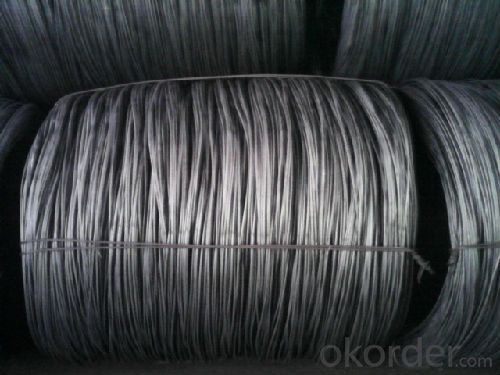
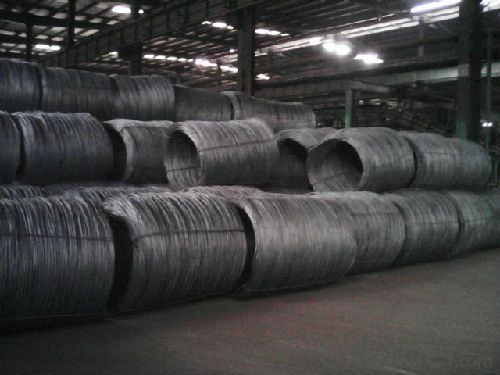
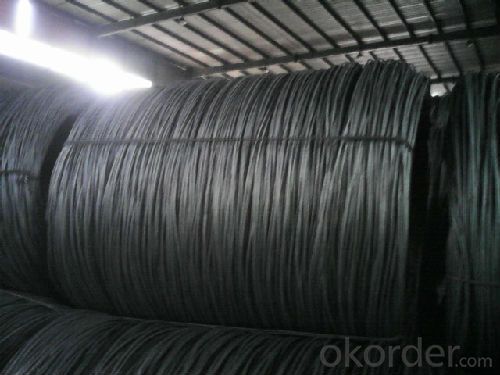
- Q: What are the advantages of using steel wire rod in railway applications?
- There are several advantages of using steel wire rod in railway applications. Firstly, steel wire rod offers high strength and durability, making it suitable for withstanding heavy loads and frequent use in railway tracks. Secondly, steel wire rod has excellent resistance to corrosion, ensuring a longer lifespan and reduced maintenance costs. Additionally, steel wire rod provides flexibility and elasticity, allowing it to absorb shocks and vibrations, which is crucial for maintaining a smooth and safe ride for trains. Lastly, steel wire rod is readily available and cost-effective, making it a preferred choice for railway infrastructure projects.
- Q: What are the main factors affecting the mechanical properties of steel wire rod?
- The main factors affecting the mechanical properties of steel wire rod include the composition of the steel, the manufacturing process, heat treatment, and the presence of impurities or defects in the material. Additionally, factors such as the diameter and strength of the wire, as well as the amount of cold work or strain applied during processing, can also impact its mechanical properties.
- Q: How is the ductility of steel wire rod determined?
- Various mechanical tests and measurements determine the ductility of steel wire rod. The tensile test is a commonly used method for evaluating ductility. During this test, a sample of the steel wire rod is pulled until it fractures, and the amount of deformation it undergoes before breaking is measured. Throughout the tensile test, the steel wire rod experiences an increasing load or force, while its elongation or deformation is continuously measured. The force needed to stretch the wire to a specific length is recorded, and a stress-strain curve is created. The stress-strain curve provides information about the ductility of the steel wire rod. The elongation or deformation at the point of fracture is a crucial parameter for assessing its ductility. A higher elongation indicates greater ductility because it means the material can withstand more deformation before breaking. In addition to the tensile test, other tests like the bend test and impact test can also evaluate the ductility of steel wire rod. During the bend test, the wire is bent to a specific angle without fracturing. The ability to bend without breaking shows good ductility. Similarly, the impact test measures the energy absorbed by the wire when it experiences a sudden impact. Higher energy absorption suggests better ductility because it means the material can absorb and distribute the impact forces without fracturing. In conclusion, the ductility of steel wire rod is determined through mechanical tests like the tensile test, bend test, and impact test. These tests assess the wire's deformation capabilities, its ability to bend without breaking, and its energy absorption during impact, respectively.
- Q: How is steel wire rod used in the production of suspension springs for agricultural machinery?
- Steel wire rod is used in the production of suspension springs for agricultural machinery as it provides the necessary strength and flexibility required to withstand the heavy loads and vibrations experienced in the field. The wire rod is typically formed into coils and then shaped and tempered to create durable and reliable suspension springs that can support the weight of the machinery and ensure smooth operation over uneven terrain.
- Q: How is steel wire rod priced in the market?
- Steel wire rod is typically priced in the market based on various factors such as global supply and demand, production costs, raw material prices, and market competition. Additionally, factors like quality, size, and delivery requirements also influence the pricing of steel wire rod. Overall, it is a dynamic process where market forces play a significant role in determining the price of steel wire rod.
- Q: How is the steel wire rod industry regulated?
- The steel wire rod industry is regulated through a combination of government regulations and industry standards. Governments typically set regulations on areas such as product quality, safety standards, environmental impact, and labor practices. These regulations ensure that the industry operates within certain parameters to protect the interests of consumers, workers, and the environment. Additionally, industry standards and certifications are often established by professional associations or organizations to further regulate and ensure the quality and safety of steel wire rod products.
- Q: What are the different types of coatings used on steel wire rod?
- There are various types of coatings used on steel wire rods, each serving a specific purpose and providing unique benefits. Some common types of coatings include: 1. Zinc Coating: Zinc is one of the most widely used coatings for steel wire rods. It provides excellent corrosion resistance, acting as a protective barrier between the steel and the surrounding environment. Zinc coatings can be applied through hot-dip galvanizing or electroplating processes. 2. Polymer Coating: Polymer coatings are often applied to steel wire rods to enhance their durability and resistance to abrasion. These coatings can be made from various types of polymers, such as polyethylene or polypropylene, and are often applied through extrusion processes. 3. Phosphate Coating: Phosphate coatings are used to improve the adhesion between the steel wire rod and subsequent coatings or paints. They provide a rough surface that enhances the bonding ability of other coatings, thereby increasing their effectiveness. 4. Epoxy Coating: Epoxy coatings are commonly used for steel wire rods that will be exposed to harsh environments, such as marine or industrial applications. These coatings offer excellent chemical resistance and durability, protecting the steel from corrosion and other forms of degradation. 5. Chrome Coating: Chrome coatings provide a highly polished and decorative finish to steel wire rods. They are often used in applications where aesthetics are important, such as in the manufacturing of furniture or automotive components. 6. Nickel Coating: Nickel coatings are used to enhance the corrosion resistance of steel wire rods in highly corrosive environments, such as marine or chemical processing applications. Nickel coatings can be applied through electroplating processes. 7. Copper Coating: Copper coatings are applied to steel wire rods to improve their electrical conductivity. They are often used in applications where the wire rod will be used for electrical purposes, such as in wiring systems or electronic devices. It is important to note that the choice of coating for a steel wire rod will depend on the specific application and the desired properties of the finished product. Furthermore, some coatings can be combined or modified to achieve specific performance requirements.
- Q: What are the different types of testing conducted on steel wire rod?
- To ensure the quality and suitability of steel wire rod for different applications, various types of testing are conducted. These tests include: 1. Chemical Analysis: This test determines the composition of the steel wire rod, including the percentages of carbon, manganese, sulfur, phosphorus, and other elements. It ensures that the rod meets the necessary specifications and standards. 2. Tensile Testing: By gradually increasing the load on the rod until it breaks and analyzing the stress-strain relationship, this test measures the strength and elasticity of the steel wire rod. It helps determine important factors like ultimate tensile strength, yield strength, and elongation, which assess the rod's quality. 3. Hardness Testing: This test gauges the steel wire rod's resistance to indentation or scratching. Techniques like Brinell, Rockwell, or Vickers hardness tests are used to determine hardness values. By evaluating wear, deformation, or penetration resistance, hardness testing determines the rod's suitability for specific applications. 4. Microstructure Analysis: The steel wire rod's internal structure and grain size are examined microscopically to identify any defects, irregularities, or inclusions that may affect its strength, ductility, or other mechanical properties. 5. Ultrasonic Testing: This non-destructive technique utilizes high-frequency sound waves to detect internal flaws or defects within the steel wire rod. It identifies issues like cracks, voids, or inclusions that could compromise the rod's integrity or performance. 6. Dimensional Inspection: This test ensures that the steel wire rod meets the required dimensional specifications, such as diameter, length, straightness, and surface finish. Tools like calipers, micrometers, or laser-based devices accurately verify these dimensions. 7. Surface Quality Assessment: Visual or non-destructive techniques are employed to inspect the rod's surface for defects like scratches, pits, scales, or corrosion. These assessments guarantee a smooth and defect-free surface, crucial for the rod's performance and appearance. These various testing methods comprehensively evaluate the steel wire rod's chemical composition, mechanical properties, microstructure, dimensions, and surface quality. Manufacturers and users conduct these tests to ensure that the rod meets the necessary standards and specifications, providing quality and reliability in industries like construction, automotive, manufacturing, and others.
- Q: How is steel wire rod used in the manufacturing of wire racks?
- Steel wire rod is a crucial component in the manufacturing of wire racks as it serves as the primary material used to create the framework and structure of the rack. The wire rod is initially processed through a series of steps such as heating, rolling, and drawing to transform it into a thin, long, and continuous wire. This wire is then bent, shaped, and welded to form the different parts of the wire rack, including the sides, shelves, and supports. The high tensile strength and durability of steel wire rod make it an ideal choice for wire racks as it can bear heavy loads and withstand constant use without bending or breaking. Additionally, the steel wire rod's corrosion resistance properties ensure that the wire racks remain sturdy and long-lasting, even in environments with high humidity or exposure to moisture. The versatility of steel wire rod allows manufacturers to create wire racks in various sizes and designs to cater to different storage needs. The wire rod can be easily manipulated to form different shapes, allowing for the creation of wire racks with adjustable shelves or collapsible features. This flexibility in design makes wire racks highly customizable and adaptable for use in various settings, such as homes, offices, warehouses, or retail stores. Furthermore, the use of steel wire rod in wire rack manufacturing enables efficient production processes. The wire rod can be easily cut, shaped, and welded using automated machinery, reducing production time and costs. This ease of manufacturing also allows for mass production of wire racks, ensuring a steady supply to meet market demands. In conclusion, steel wire rod plays a vital role in the manufacturing of wire racks by providing the necessary strength, durability, and versatility required for these storage solutions. Its ability to be easily shaped, resistance to corrosion, and cost-effectiveness make it an ideal material for creating wire racks of various sizes and designs.
- Q: What are the different surface defects that can affect the fatigue strength of steel wire rod?
- Some common surface defects that can affect the fatigue strength of steel wire rod include surface cracks, pits, scratches, and corrosion. These defects can act as stress concentrators, leading to the initiation and propagation of fatigue cracks, ultimately reducing the fatigue strength of the wire rod. Proper surface treatment and inspection are essential to minimize these defects and improve the fatigue performance of steel wire rods.
Send your message to us
Wire Rod High Qulity Hot Rolled Sae 1008b 5.5mmin Coils
- Loading Port:
- Tianjin
- Payment Terms:
- TT or LC
- Min Order Qty:
- 25 m.t.
- Supply Capability:
- 20000 m.t./month
OKorder Service Pledge
OKorder Financial Service
Similar products
Hot products
Hot Searches
Related keywords
